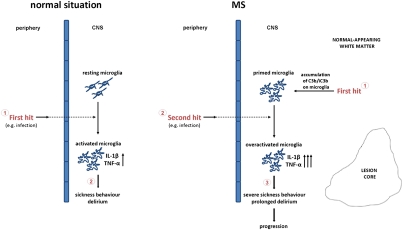Fig. 6.
Model of microglial priming. In the normal situation, a peripheral event, such as an infection, is the first hit to the brain (via mechanisms yet to be defined and discussed in the text), activating resting microglia to produce inflammatory mediators affecting neuronal function and producing sickness behavior or delirium. In pathological situations such as MS, a first hit (disease) primes microglia for overactivation in response to a second hit. In normal-appearing brain tissue, accumulation of C3b/iC3b on microglia, either secondary to preexisting neurodegeneration or caused by a primary (possibly genetic) dysregulation of C3 activation, is the first hit that primes microglial cells. Under these circumstances, a peripheral injurious event, such as an infection, is the second hit to the brain that overactivates primed microglia to produce an elevated amount of inflammatory mediators, determining severe sickness behavior and prolonged delirium leading to disease progression.

